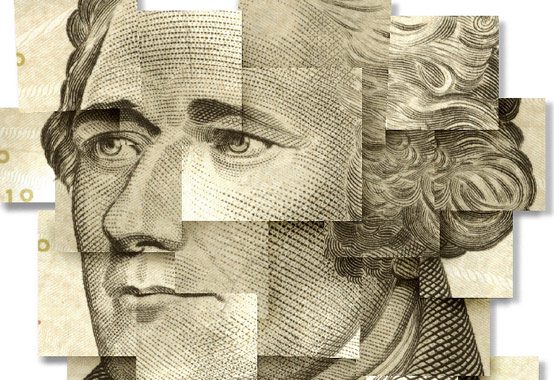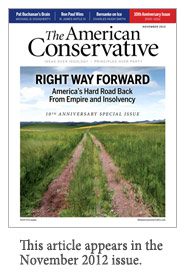Founding Financiers

In a source I cannot now recall, I once read that following the failure of a movie set during the era of the American Revolution a Hollywood mogul decreed: “No more quill pen pictures!” The studio head’s commercial instincts were sound. In public consciousness, the Civil War marginalizes the War of Independence, and American history between the Founding and the Jacksonian era has been lost to a kind of collective amnesia. The American republic in its first few decades, with its East Coast patricians and aristocrats, its balls and wigs and buckled shoes, seems more like a detached fragment of the Old World than the germ of a New, best suited for cinematic treatment by “Masterpiece Theater” or Merchant and Ivory.
Thomas McCraw’s The Founders and Finance is not likely to be optioned by Hollywood for a big-budget motion picture. Bankers and immigrants have always been viewed with suspicion by a certain strain of American populism, and McCraw’s story is about immigrant bankers. But subsequent American history is rooted in the thoughts and actions of McCraw’s subjects, even if the tale won’t soon be coming to your neighborhood metroplex.
Four of the first six secretaries of the U.S. Treasury—serving for a cumulative 21 of the first 27 years of the U.S. under the federal Constitution—had been born abroad. They were Alexander Hamilton, born in St. Croix in the Caribbean; Albert Gallatin, born in Geneva, Switzerland; George W. Campbell, born in Scotland; and Alexander James Dallas, born in Jamaica.
These foreign-born Treasury secretaries were only a few of the immigrants who contributed disproportionately to the development of the American financial system in the early decades of the republic. Other Treasury officials included Joseph Nourse, an immigrant from London, and William Duer, a native of Devonshire who quit the U.S. Treasury in order to speculate and helped to cause the first great financial panic in the United States. A Jewish financier from Poland, Haym Solomon, contributed to financing the war of the American colonists against Britain, while a French sailor and merchant named Stephen Girard became one of the richest men in the early United States. Girard joined with John Jacob Astor, a butcher’s son from Germany who became an American tycoon, and David Parish, German-born scion of a British banking dynasty, to rescue the finances of the federal government during the War of 1812—in those days the rich bailed out the government, not vice versa. Even more important was Robert Morris, an immigrant from Liverpool who became a leading Philadelphia merchant and the first superintendent of finance appointed by Congress during the Revolutionary War. Before modern bankruptcy laws were enacted, finance was a high-risk as well as a high-reward business, and both Duer and Morris died in disgrace in debtors’ prison.
No one is better suited to recover their stories than Thomas K. McCraw. An emeritus professor at Harvard Business School, McCraw has a strong claim to status as the dean of American economic historians, a worthy successor to Alfred Chandler, some of whose work McCraw edited and presented in The Essential Alfred Chandler. McCraw won a Pulitzer Prize in 1984 for Prophets of Regulation: Charles Francis Adams, Louis D. Brandeis, James H. Landis, and Alfred E. Kahn. Among McCraw’s other major contributions to economic history is the recent Prophet of Innovation: Joseph Schumpeter and Creative Destruction.
Using a technique borrowed from Plutarch that he earlier employed in Prophets of Regulation, McCraw structures The Founders and Finance in the form of parallel lives of Hamilton and Gallatin. Hamilton was a poor orphan from St. Croix—the illegitimate son of the fourth son of a Scottish aristocrat—who married into a rich New York family, dreamed of military glory, and served George Washington as aide-de-camp during the revolution and as de facto prime minister during Washington’s presidency, only to die in a duel in 1804 at the hands of Jefferson’s vice president Aaron Burr. Hamilton could hardly have been more different from Gallatin, a Genevan patrician who sided with Hamilton’s political enemies—the frontiersmen, working-class urban-dwellers, and Southern planters who looked to Thomas Jefferson as their cynosure. Gallatin first came to prominence among the Jeffersonians as a well-informed critic of Hamilton’s plans during the 1790s for the federal assumption of state debts left over from the Revolutionary War, for a national bank, and for government support of manufacturing.
But once he was appointed as secretary of the Treasury when Jefferson assumed the presidency in 1801, Gallatin set forth a vision of federally guided national economic development that was similar in many ways to Hamilton’s. Gallatin not only followed Hamilton in publishing a state paper on manufacturing—he plausibly argued that favorable public credit to manufacturers was preferable to subsidies or tariffs—but also came up with a grandiose scheme for a nationwide canal network, which was, however, quickly rendered obsolete by the replacement of canals by railroads.
Why did the post-colonial United States lack native-born Americans who understood commerce and finance as well as Hamilton, Gallatin, and the others? McCraw notes:
Within the colonies, the functions of managing currencies, collecting taxes, and spending on defense and public works had been performed either by British administrators serving in America or by local officials. … Morris, Hamilton, Gallatin and other immigrants plugged the many institutional holes in a multilayered system undergoing very rapid change.
McCraw might have devoted more space to describing the ways in which the mercantilist economic system of the British empire left its former colonies ill-prepared for existence as parts of a sovereign nation-state. Although Britain began to champion free trade in the mid-19th century, after it became the first industrial superpower and sought to open foreign markets for its machine-made goods; previously British economic policy was based on empire-wide protectionism, a division of labor among manufacturers in Britain, and colonists who supplied raw materials to the manufactories of the metropole.
Indeed, the manufacture of many high-value-added goods was forbidden by law in the American colonies. The British Board of Trade in 1721 told the king: “Having no manufactories of their own, their… situation will make them always dependent on Great Britian.” Edmund Burke, who sympathized with the Americans, told Parliament: “These colonies were evidently founded in subservience to the commerce of Great Britain.” On gaining their independence, the American colonies—now states—found themselves in an economic situation similar to that of today’s former Soviet republics, whose economies had been part of a larger, integrated system that has now been disrupted.
Turning these fragments of an empire into the nucleus of another great military and economic power was more difficult than it may seem in hindsight. Similar challenges were faced by the former Spanish and Portuguese colonies of Latin America following their independence, with radically different outcomes. While Britain’s former North American colonies, outside of Canada, were welded into a union that survived a titanic civil war, Spain’s colonies crumbled into a Balkanized patchwork of independent countries. And while the United States was able to exploit economies of scale in a single continental market to catch up with and then surpass Britain as an industrial colossus, for most of their history the “banana republics” of Latin America have combined nominal political independence with a quasi-colonial role in the world economy as commodity exporters to more advanced industrial economies.
A Balkanized, underdeveloped, non-industrial America, supplying food, timber, and energy to industrial Europe and, later, to industrial Asia was always a possible alternative in successive crises in American history from the Founding to the Civil War, and conceivably could be again someday. McCraw observes:
A fusion of many of Hamilton’s and Gallatin’s policies found expression in an economic program that came to be called the ‘American System’—the fullest program for national economic development since Hamilton’s Reports of 1790–1791. In speeches and legislative bills beginning in 1815 and continuing for two decades, Henry Clay and many others sketched out blueprints for the establishment and then continuation of the Second Bank of the United States, for federal aid to build roads and canals, for development of the West, and for the encouragement of manufactures through high levels of tariff protection. On each of these goals except for the high protective tariffs, the American System mirrored the policies of both Hamilton and Gallatin.
McCraw notes that, given a choice among four possible economic strategies—laissez-faire reliance on the market; uncoordinated intervention in markets by city, county, state and national governments; systematic government guidance of economic decisions; and top-down, comprehensive government economic management—the U.S. has oscillated between the first and the second: “And only during periods of major war (1861–1865, 1917–1918, 1941–1945) has it taken up even temporary residence in category three. Category two—frequent but uncoordinated intervention in mostly free markets—has been the American way of public economic management.”
 Ultimately, according to McCraw, “the dream of an integrated, diversified, and booming economy—the aspiration of Hamilton, Gallatin, and many other immigrant nationalists—eventually came true.” Because his view is retrospective, McCraw does not speculate on what his subjects might think about the present condition of their adopted country. But if ever there were a bipartisan consensus worth preserving and promoting, it is to be found in what Hamilton and Gallatin shared: an emphasis on the legitimacy of government borrowing for the right purposes, combined with an appreciation of the need for the nation to have a sound credit rating in order to keep borrowing costs low; the need for ambitious and comprehensive systems of public infrastructure development, without which markets are fragmented and businesses are taxed by inefficiency; and, above all, a vision of the national interest, a vision which may come less easily to native-born Americans with parochial attachments and local loyalties than to immigrants to the United States who can view their adopted country as a whole.
Ultimately, according to McCraw, “the dream of an integrated, diversified, and booming economy—the aspiration of Hamilton, Gallatin, and many other immigrant nationalists—eventually came true.” Because his view is retrospective, McCraw does not speculate on what his subjects might think about the present condition of their adopted country. But if ever there were a bipartisan consensus worth preserving and promoting, it is to be found in what Hamilton and Gallatin shared: an emphasis on the legitimacy of government borrowing for the right purposes, combined with an appreciation of the need for the nation to have a sound credit rating in order to keep borrowing costs low; the need for ambitious and comprehensive systems of public infrastructure development, without which markets are fragmented and businesses are taxed by inefficiency; and, above all, a vision of the national interest, a vision which may come less easily to native-born Americans with parochial attachments and local loyalties than to immigrants to the United States who can view their adopted country as a whole.
Michael Lind is co-founder of the New America Foundation and author of Land of Promise: An Economic History of the United States.
Comments